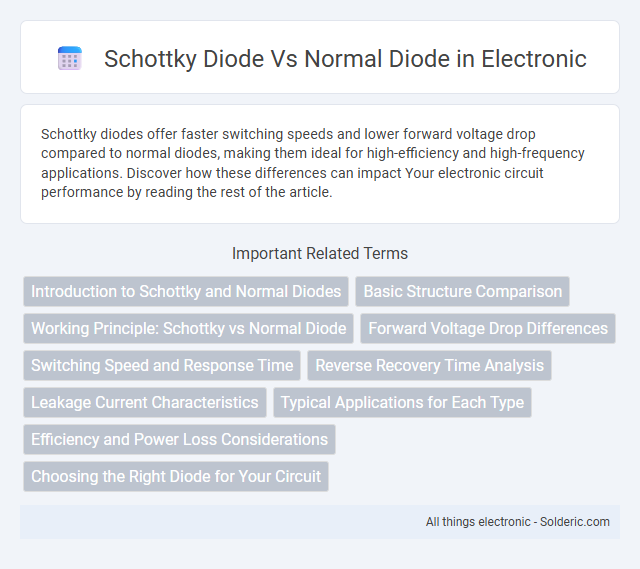Schottky diodes offer faster switching speeds and lower forward voltage drop compared to normal diodes, making them ideal for high-efficiency and high-frequency applications. Discover how these differences can impact Your electronic circuit performance by reading the rest of the article.
Comparison Table
| Feature | Schottky Diode | Normal Diode (PN Junction) |
|---|---|---|
| Material | Metal-Semiconductor Junction | Semiconductor-Semiconductor Junction (PN Junction) |
| Forward Voltage Drop | 0.15 - 0.45 V (Lower) | 0.6 - 1.0 V (Higher) |
| Switching Speed | Very Fast (Nanoseconds) | Slower (Microseconds) |
| Reverse Recovery Time | Minimal (Near Zero) | Significant |
| Leakage Current | Higher | Lower |
| Applications | High-speed switching, Power rectifiers, RF circuits | General rectification, Voltage regulation |
| Cost | Generally Higher | Generally Lower |
Introduction to Schottky and Normal Diodes
Schottky diodes differ from normal diodes primarily in their construction, using a metal-semiconductor junction instead of a p-n junction, which results in lower forward voltage drop and faster switching speeds. Normal diodes, typically made with a p-n junction, have higher forward voltage and slower response times but offer greater voltage tolerance and robustness. Understanding these fundamental differences helps you choose the right diode for applications such as power rectification or high-speed switching.
Basic Structure Comparison
A Schottky diode features a metal-semiconductor junction, while a normal diode uses a p-n semiconductor junction. This metal-semiconductor interface in Schottky diodes results in lower forward voltage drop and faster switching speeds compared to the higher voltage drop and slower switching of p-n junction diodes. Understanding these structural differences helps you select the appropriate diode for high-speed or low-voltage applications.
Working Principle: Schottky vs Normal Diode
Schottky diodes operate based on the metal-semiconductor junction, allowing majority carriers to conduct with minimal charge storage, which results in faster switching and lower forward voltage drop compared to normal diodes. Normal diodes rely on a p-n junction where both majority and minority carriers participate, causing slower switching speeds and higher forward voltage. Your choice between these diodes should consider the speed and efficiency requirements of your electronic circuit.
Forward Voltage Drop Differences
Schottky diodes typically have a forward voltage drop of 0.15 to 0.45 volts, significantly lower than the 0.7 volts found in standard silicon diodes. This lower forward voltage drop reduces power loss and improves efficiency in high-frequency and low-voltage applications. Consequently, Schottky diodes are preferred in switching power supplies and RF circuits where minimizing voltage drop is crucial.
Switching Speed and Response Time
Schottky diodes exhibit significantly faster switching speeds and lower response times compared to normal p-n junction diodes due to their metal-semiconductor junction, which eliminates charge storage effects. This results in switching times typically in the nanosecond range, making Schottky diodes ideal for high-frequency applications. Normal diodes, on the other hand, have slower switching speeds in the microsecond range because of minority carrier recombination delays.
Reverse Recovery Time Analysis
Schottky diodes exhibit significantly lower reverse recovery time compared to normal p-n junction diodes due to their metal-semiconductor junction, which eliminates charge storage in the depletion region. This characteristic enables faster switching speeds, reducing switching losses in high-frequency applications such as power converters and RF circuits. In contrast, normal diodes have longer reverse recovery times caused by minority carrier recombination in the depletion region, leading to increased power dissipation and electromagnetic interference.
Leakage Current Characteristics
Schottky diodes exhibit significantly lower forward voltage drop and faster switching times compared to normal PN-junction diodes, but they have higher leakage current characteristics, especially at elevated temperatures. The leakage current in Schottky diodes can be several orders of magnitude greater due to their metal-semiconductor junction, which affects efficiency in high-temperature applications. Understanding these leakage current differences is crucial for optimizing your circuit design to balance performance and power loss.
Typical Applications for Each Type
Schottky diodes are commonly used in high-speed switching applications, power rectification, and voltage clamping due to their low forward voltage drop and fast recovery time. Normal diodes, such as silicon PN junction diodes, are typically employed in general-purpose rectification, signal demodulation, and voltage regulation where switching speed is less critical. In power supply circuits, Schottky diodes improve efficiency by reducing conduction losses, while normal diodes provide robust performance in higher voltage and current scenarios.
Efficiency and Power Loss Considerations
Schottky diodes exhibit lower forward voltage drop, typically around 0.2 to 0.3 volts, compared to standard silicon diodes with forward drops of about 0.7 volts, resulting in higher efficiency and reduced power loss during conduction. The reduced voltage drop minimizes heat generation and improves overall energy efficiency in high-frequency and low-voltage applications. Schottky diodes also feature faster switching speeds, which contribute to lower switching losses and enhanced performance in power-sensitive circuits.
Choosing the Right Diode for Your Circuit
Schottky diodes feature lower forward voltage drop (typically 0.2-0.3V) compared to normal silicon diodes (about 0.7V), making them ideal for high-efficiency power applications and fast switching circuits. Their fast switching speed and low reverse recovery time enhance performance in RF and power supply designs, while normal diodes offer higher reverse voltage tolerance and better thermal stability. Choosing the right diode for your circuit depends on balancing efficiency, switching speed, voltage requirements, and thermal considerations.
Schottky diode vs Normal diode Infographic

 solderic.com
solderic.com